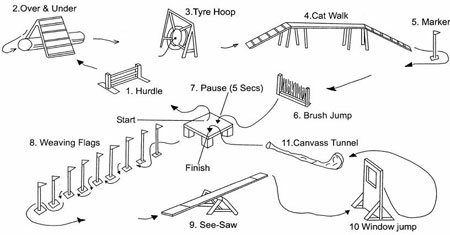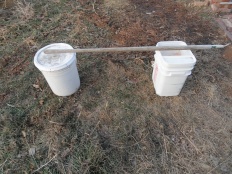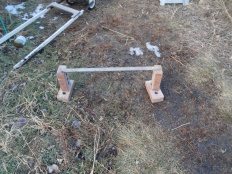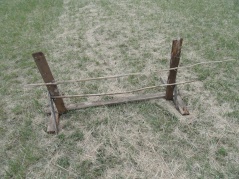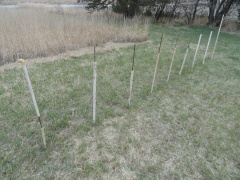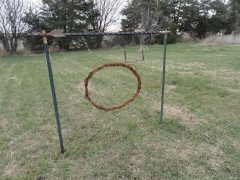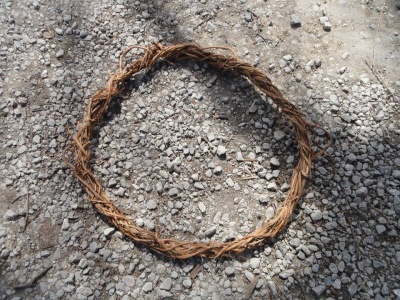Agility Ideas
Of the Dogge called a Tumbler, in Latine Vertagus.
This sorte of Dogges, which compasseth all by craftes, fraudes, subtelties and deceiptes, we Englishe men call Tumblers, because in hunting they turne and tumble, winding their bodyes about in circle wise, and then fearcely and violently venturing upõ the beast, doth soddenly gripe it, at the very entrance and mouth of their receptacles, or closets before they can recouer meanes, to saue and succour themselues. This dogge vseth another craft and subteltie, namely, when he runneth into a warren, or setteth a course about a connyburrough, he huntes not after them, he frayes them not by barcking, he makes no countenance or shadow of hatred against them, but dissembling friendship, and pretending fauour, passeth by with silence and quietnesse, marking and noting their holes diligently, wherin (I warrant you) he will not be ouershot nor deceaued. When he commeth to the place where Connyes be, of a certaintie, he cowcheth downe close with his belly to the groũd, Prouided alwayes by his skill and polisie, that ye winde bee neuer with him but against him in such an enterprise. And that the Connyes spie him not where he lurcketh. By which meanes he obtaineth the sent and sauour of the Connyes, carryed towardes him with the wind & the ayre, either going to their holes, or cõming out, eyther passing this way, or running that way, and so prouideth by his circumspection, that the selly simple Conny is debarred quite from his hole (which is the hauen of their hope and the harbour of their health) and fraudulently circumuented and taken, before they can get the aduantage of their hole. Thus hauing caught his pray he carryeth it speedily to his Master, wayting his Dogges returne in some conuenient lurcking corner. These Dogges are somewhatlesser than the houndes, and they be lancker & leaner, beside that they be somwhat prick eared. A man that shall marke the forme and fashion of their bodyes, may well call them mungrell Grehoundes if they were somwhat bigger. But notwithstanding they counteruaile not the Grehound in greatnes, yet will he take in one dayes space as many Connyes as shall arise to as bigge a burthen, and as heauy a loade as a horse can carry, for deceipt and guile is the instrument wherby he maketh this spoyle, which pernicious properties supply the places of more commendable qualities. ‘De Canibus Britannicus’ Dr Johannes Caius, England, Latin 1570, (‘Of English dogges’) English 1576 -[[1]]
[William, d. 1328.] “The art of hunting” mentions the hunting of vermin in a couple of places. (Free ebook on Google books).
[George, 1540-1610?] "The Noble Art of Venerie" discusses the use of terriers on page 180-2, 192-6, https:archive.org/stream/turbervilesbook00turbgoog#page/n197/mode/2up
Humans and dogs working together to catch rats (these little guys are amazing):
Gulf Wars - [[5]] (requires like coursing with like to avoid injury... Apparently include agility and tracking type activity under what they call coursing. The equipment is made to look more like stuff one would encounter in a forest hunting situation...)
Agility is a test of communication and team work skills between man and beast. Often a failed run is not because the dog messes up but because the human partner makes a mistake. Agility is something that any dog can do and relatively fair competitions can be devised as long as adjustments are made for the size of the dogs and the heights of the jumps.
Real World Agility Games:
In standard agility competitions, dogs are measured for height at the withers. They are then sorted into small medium and large dogs... the jumps would be set higher for larger dogs and lower for the small ones. The small dogs also had slightly shorter distance between jumps and overall distance to run while the large dogs required a little more clearance to land and set themselves for the next jump... [[6]]
| Jump Height | AKC - height at withers | USDAA - height | CPE - height | UKC - height | NADAC - height |
| 4" | Small breeds may do a optional “preferred” 4” class. | 8” or less | |||
| 8" | 10" and under | 12” or less | 14" and under | 11’’ and under | |
| 12" | under 14" | 12" and under | 16” or less | 14” and under | |
| 14" | under 20" | ||||
| 16" | under 18" | under 16" | 20” or less | 18” and under | |
| 20" jump | under 22" | 24” or less | 20” and under | ||
| also | |||||
| over 20” | |||||
| 22" jump | under 21" | ||||
| 24" jump | over 22" | over 24” | over 20" | ||
| 26" jump | over 22” may do a 26” jump class. | over 21": 26" jump | |||
| Older dogs may do “preferred” classes at lower heights. | |||||
| In UKC, the Broad Jump is twice the dog’s height at the shoulders, rounded down to the nearest even number (so a dog 17.5 inches at the wither would have a 34 inch broad jump, while an 18 inch dog would broad jump 36 inches). In AKC it is twice the jump height for the division (so a 17.5 inch dog is in the 16" division and would broad jump 32 inches, while an 18 inch dog would be in the 20" division and broad jump 40 inches). |
There were two types of events with separate titles. “Jumps” and “obstacles” are generally spread out over a roughly 100 by 100 foot area. There are other devices like barriers you can't see through to jump over and things that must be crawled under in different organizations. Before the event starts and after the track is set up the handlers are given time (without their dogs) to learn and walk the track....
Dogs... must run the course in a specified amount of time (based on size, experience level) making less than a specified amount and kind of mistakes. As the levels go up the courses get tighter, longer, more difficult and less time and fewer mistakes are allowed... When a dog gets its title it is tradition that it gets to keep the bar from its “winning” jump. I have seen several dogs have the bar tossed to them and they proudly prancing around the course. Everyone signs it and it goes home with the dog a trophy to keep...
*Gambler or F.A.S.T. (AKC) games involve earning as many agility points as possible in a set time (in any order), then a bonus set of obstacle to be run at a distance (the handler has to stay out of the taped off area with 2-3 obstacles to be run in a certain order). Contact obstacles and long weaves (10-12 poles) worth 5 pts). Tunnels and short weaves (5-6 poles) worth 3 points. Jumps worth 1 point each, max of 6 points to be earned. An obstacle can generally be run twice for points in a single round, more than that is no additional points, but no penalty unless it looks like "training" or "loitering".
- Barn Hunt - a fairly new sport for dogs meant to emulate more of the skills used by vermin-hunting dogs, not just the underground tunnel activities of earthworking. It's primarily scent work but some agility! [[7]] (watch the Great Dane go through the little tunnel!)
Ideas for SCA agility games:
The first change to make this game SCA appropriate is to make the equipment look period. Jumps could be made from sticks, trees, ropes, canvas, wicker/wattle or brush instead of pvc pipe and plastic. Maybe paper mache rocks (Light weight for packing) as the signs for the numbers. And so on. As long as it is deemed safe, even random pieces of camping gear could be used as jumps.
Possible scenarios/inspiration:
- Escape from a siege
- A tavern adventure with tables and chairs etc.
- “Calon Army Run" where the obstacle are made from scutums and the jump bars are rattan weapons.
- Rat/rabbit hunting (incorporate scent tracking - trail the scented "rabbit" dragged along/through the course?)
- Sheriff using dogs to search for contraband/criminals (with scent tracking?)
Possible obstacles:
- tunnels through "strawstacks" (earth pimple with grass covering?) or simulated burrows (under paper mache stones?)
- "dog walk" bridge across reed bed or ramps into "chicken coops" (pause table)
- jumping through wattle fences/canvas simulated timber frame (windows at different levels for different-sized dogs?)
- broad jumping/climbing over paper mache stone fences or logs
- a shrubbery!
- weaving through simulated walk-through fence stiles or a simulated coppice
- searching through reed beds (also use reeds as wings for obstacles?)
- A-frame "thatch" roof with plank path (use duck blind grass mats for the "thatch")
- well-wheel?
- are see-saws or teeter-totters period?
- Tales from the Green Valley TV series for further inspiration - [[8]]
Some method of jump height vs dog needs to be devised, and to avoid lots of re-setting up we could lead dogs between two lines and count the number of steps takes takes them then adjust run times accordingly.
Timekeeping (i.e. annoying stopwatches) could be minimized by putting more emphasis on clean completion of obstacles rather than speed - points earned for each obstacle, more points for more difficult obstacles, points subtracted (or added like in golf?) for repeated attempts at an obstacle. Similar to "Gambler" or "FAST" agility games.
Or if the scenario is based on searching/hunting, then a bounty could be earned for each "rat" bagged - Fast Ratter Game.
CHEEP AGILITY EQUIPMENT:
Agility for mundane competitions is very specified. I imagine that is so that the titles are not harder to get in one place than another. What you use at home can be very creative so long as it is safe for the dog. Here are some examples for jumps. The cross bars can just be sat on the top of something but don't fasten them down The more different things you use the more Competitions is very specified. I imagine that is so that the titles are not harder to get in one place than another. What you use at home can be very creative so long as it is safe for the dog. Here are some examples for jumps. The cross bars can just be sat on the top of something but don't fasten them down your dog is likely to be. Competitions is very specified. I imagine that is so that the titles are not harder to get in one place than another. What you use at home can be very creative so long as it is safe for the dog. Here are some examples for jumps. The cross bars can just be sat on the top of something but don't fasten them down. The more different looking your jumps at home are the more versatile your dog will be and the less likely he is to get weirded out by something that looks a little different.
Start with height set low. Move them higher as he gains proficiency. Try motivating him with a treat or toy. Praise him when he makes a successful jump, and later when he has done several in a row.
More DIY:
The UKC has an interesting variety of obstacles, hurdles and jumps: the crawl tunnel and the hoop tunnel; bush hurdle, high hurdle, log hurdle, picket fence hurdle, rail fence hurdle, long hurdle, window hurdle, and water hurdle; swing plank, sway bridge, broad jump and platform jump - [[11]],
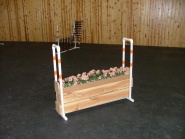 |
 |
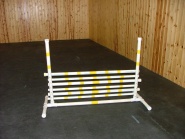 |
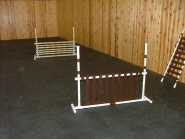
|
| 127x91px | 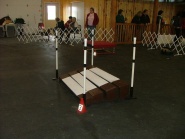 |
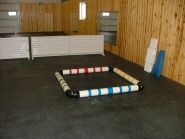 |
191x139px |
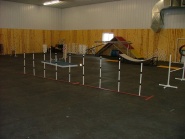 |
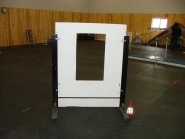 |
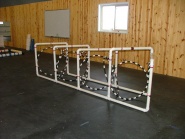 |
191x139px |
The UKC seems to have good attitude about their competitions, focusing on teamwork and coordination instead of speed -
[[12]]
[[13]]
[[14]]
A tree/sunflower stalk jump by Master Gerald:
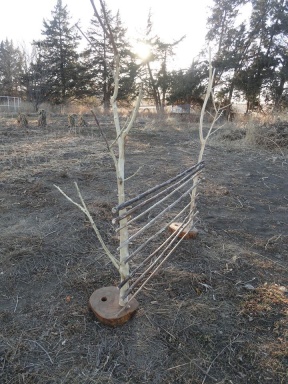 |
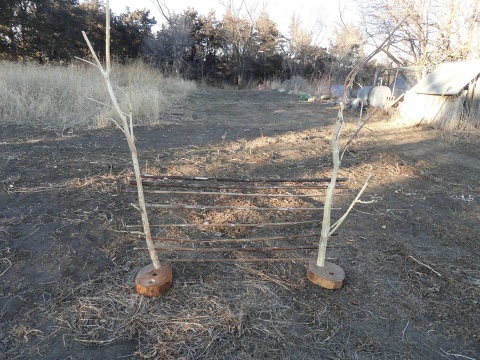 |
|

|
"From How to Design a Dog Agility Course" by Cindy Quarters
- Plan for the fluidity of the course, so that a dog and handler team negotiating the obstacles can move smoothly from one task to the next. The USDAA recommends a distance of at least 18 feet between obstacles for this reason, with an average spacing of 18 to 22 feet. Exceptions may be made for specific obstacles.
- Determine the appropriate challenges for the course... can include such challenges as object discrimination, where the dog must go to the correct obstacle based on the handler’s direction, and handler constraint, where objects block the handler’s path and he must direct his dog from a distance. Note that the objects must not be anything the handler could trip over. Use specialized agility course design software or a pencil and graph paper to plan the arrangement of the obstacles based on the course requirements.
- Include adequate room for the judge to move in and around the obstacles, so that she can clearly see the dog and handler as necessary. This is of particular importance near the contact obstacles, weave poles, long jump and table... It is important to make sure that the judge’s path and the agility team’s paths don’t cross at any time. Ensure that the judge has a clear view of all obstacles along the planned judging path.
- Place the start and finish lines in a way that allows for accurate timing of the dog, with obstacles set far enough back to allow a clear view of the dog at both points...
- Review the placement of all obstacles and be sure the course is safe. For some obstacles, such as the teeter-totter and the A-frame, angles greater than 45 degrees are not allowed by the USDAA due to safety considerations. These must also not be located in such a way that the dog will approach them at high speed. Check the location of other obstacles as well for safety violations, both on the approach and in the landing zone. For most jumps the landing zone should be at least 12 to 15 feet long.
- [[15]]
Sample course layouts with brief handling suggestions - [[16]]
